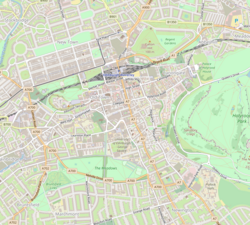St Mary's Cathedral, Edinburgh (Catholic)
Church in Edinburgh, Scotland From Wikipedia, the free encyclopedia
The Metropolitan Cathedral of Our Lady of the Assumption, also known as St Mary's Metropolitan Cathedral, is a Roman Catholic church in Edinburgh, Scotland. It is the seat of the Archbishop of Saint Andrews and Edinburgh and the mother church of Scots Catholicism.[1] The cathedral church is located at the East End of New Town in the city center.
| St Mary's Metropolitan Cathedral | |
|---|---|
| St Mary's Metropolitan Cathedral (of the Assumption) | |
 | |
| 55.9561°N 3.1877°W | |
| Location | Edinburgh |
| Country | Scotland |
| Denomination | Roman Catholic |
| Website | www |
| History | |
| Former name(s) | St Mary's Chapel (1814) |
| Status | Metropolitan Cathedral (of the Province of St Andrews and Edinburgh) |
| Consecrated | 1814 |
| Associated people | Sir Arthur Conan Doyle christened; under Charles Hargitt The Edinburgh Royal Choral Union (1858), under Arthur Oldham The Edinburgh Festival Chorus and The Scottish Opera Chorus were founded with a nucleus from the Cathedral Choir. |
| Architecture | |
| Heritage designation | Listed B |
| Architect(s) | James Gillespie Graham |
| Years built | 1814 |
| Administration | |
| Province | St Andrews and Edinburgh |
| Archdiocese | St Andrews and Edinburgh |
| Clergy | |
| Archbishop | Leo Cushley |
| Laity | |
| Director of music | Michael Ferguson |

History
The Chapel of St Mary's was opened in 1814, and was originally designed by James Gillespie Graham. It was built in replacement of the Chapel of St Andrew the Apostle on Blackfriars Wynd (which had been tolerated despite Scotland not recognising the Catholic faith). The building of a purpose-built church recognises a broad acceptance of the faith by 1814.[2]
The church was considerably embellished over the years, and in 1878 on the restoration of the Scottish hierarchy it became the pro-cathedral of the new Archdiocese of St Andrews and Edinburgh. It was renamed the Metropolitan Cathedral on 5 July 1886 with all the rights and privileges appertaining to such a church. It contains the National Shrine of St. Andrew.[3]
Pope John Paul II visited St Mary's in May 1982, as part of his pastoral visit to Scotland.
Architecture
The cathedral was designed in 1813–1814 in the neo-perpendicular style by James Gillespie Graham, with additional designs by Augustus Pugin.[4][5]
In 1892 a fire at the neighbouring Theatre Royal required changes to the cathedral. Arches were made in the side walls and aisles were added on both sides, designed by John Biggar. The sanctuary was extended backwards by three bays of arches.[6]
The war memorial and high altar were added in 1921, designed by Reginald Fairlie. A baldachino was added in 1927.[4] In 1932 the height of the roof was increased by Reid and Forbes.[6]
In the 1970s, the front of the cathedral was opened up due to the demolition of tenement buildings. The porch and baptistery were replaced by a larger porch, designed by T. Harley Haddow, and the sanctuary was remodelled to meet the requirements of the Second Vatican Council.[6]
Music
The Schola Cantorum has eight singers and sings a wide range of sacred music including plainchant, renaissance polyphony and modern compositions. In addition, there is a mixed-ability cathedral choir.[7]
A new organ was installed in 2008, built by Matthey Copley and having 4,000 pipes.[6]
The Director of Music is Michael Ferguson, who also teaches at the University of St Andrews and is a composer.[7] The organist is Simon Leach.[8]
Concerts and recitals were held in the cathedral during the Edinburgh Festival Fringe from 2009 to 2016.[9]
Current clergy
- Mgr Patrick Burke, VG (administrator); Fr Robert Taylor
- Fr Tadeusz Puton SAC (non-resident), Chaplain of the Polish Mission[10]
Parish organisation
From 2017 the many parishes in Edinburgh have been organised into clusters to better coordinate their resources. St Mary's Cathedral is one of four parishes in Cluster 1 along with St Ninian and Triduana, St Patrick and St Albert.[11]
Cafe Camino
The cathedral formerly operated a café in an adjoining building. It was used as a venue as part of the Free Fringe at the Edinburgh Festival Fringe.[12]
See also
References
External links
Wikiwand in your browser!
Seamless Wikipedia browsing. On steroids.
Every time you click a link to Wikipedia, Wiktionary or Wikiquote in your browser's search results, it will show the modern Wikiwand interface.
Wikiwand extension is a five stars, simple, with minimum permission required to keep your browsing private, safe and transparent.

